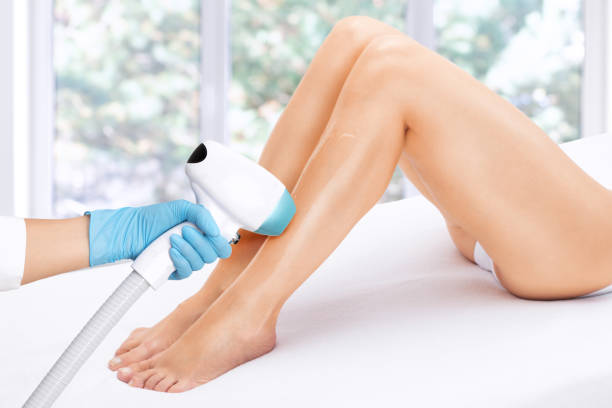- Hair Color and Skin Tone: Lasers target the pigment (melanin) in hair. Dark hair absorbs the laser energy better, leading to more effective treatment. Light-colored hair (blonde, red, gray, or white) has less melanin and may not respond well to laser treatments. Additionally, individuals with darker skin tones may face challenges as the laser can sometimes be absorbed by the skin pigment, leading to reduced effectiveness and potential skin damage.
- Hair Growth Cycle: Hair grows in cycles, and laser hair removal is most effective during the active growth phase (anagen). Not all hairs are in the same phase at any given time, so multiple treatments are required to target hairs in the appropriate phase.
- Hormonal Imbalances: Conditions like polycystic ovary syndrome (PCOS) or other hormonal disorders can cause excessive hair growth. In such cases, laser hair removal may be less effective as new hair growth continues due to underlying hormonal issues.
- Laser Type and Settings: Different types of lasers (e.g., Alexandrite, Diode, Nd
) are suitable for different skin types and hair colors. Incorrect settings or using the wrong type of laser for a person’s specific skin and hair type can reduce effectiveness.
- Treatment Area: Some areas of the body may respond better to laser hair removal than others. For instance, facial hair can be more stubborn compared to body hair due to hormonal influences.
- Preparation and Aftercare: Proper preparation before the treatment and aftercare are crucial. Shaving the area before treatment ensures the laser targets the hair follicle directly. Post-treatment care, such as avoiding sun exposure, helps prevent complications and ensures better results.
- Medications and Medical Conditions: Certain medications and medical conditions can affect the outcome of laser hair removal. Photosensitive medications can make the skin more susceptible to damage, and some medical conditions might interfere with the treatment’s effectiveness.
- Technician Skill and Experience: The expertise of the person performing the laser hair removal is critical. Skilled and experienced technicians can adjust settings and techniques to suit individual needs, leading to better outcomes.
Addressing these factors can improve the effectiveness of laser hair removal. Consulting with a qualified professional to assess individual suitability and customize the treatment plan is essential for optimal results.

How can I maximize my laser hair removal results?
To maximize your laser hair removal results, follow these guidelines:
- Choose the Right Provider:
- Select a reputable clinic with experienced and certified technicians.
- Ensure they use appropriate laser technology for your skin type and hair color.
- Pre-Treatment Preparation:
- Shave the Area: Shave the treatment area 24-48 hours before your session. Avoid waxing, plucking, or using depilatory creams for at least 4-6 weeks prior, as these remove the hair root, which the laser targets.
- Avoid Sun Exposure: Stay out of the sun and avoid tanning (including tanning beds and self-tanners) for at least 2 weeks before treatment. Tanned skin can increase the risk of burns and make the treatment less effective.
- Clean Skin: Ensure the area is clean and free of makeup, lotions, deodorant, or any other skincare products before the session.
- During Treatment:
- Communicate with the Technician: Inform the technician of any discomfort during the procedure so they can adjust settings if necessary.
- Stay Consistent: Follow the recommended treatment schedule. Laser hair removal requires multiple sessions, typically spaced 4-6 weeks apart, to target hair in different growth cycles.
- Post-Treatment Care:
- Avoid Sun Exposure: Protect the treated area from sun exposure and use a broad-spectrum sunscreen with SPF 30 or higher for several weeks post-treatment.
- Avoid Heat: For at least 24-48 hours post-treatment, avoid hot showers, saunas, steam rooms, and intense exercise that causes sweating.
- Moisturize: Keep the treated area moisturized with a gentle, fragrance-free lotion.
- Avoid Irritants: Do not use harsh skincare products, such as retinoids or glycolic acids, on the treated area for a few days after the session.
- Monitor and Manage Side Effects:
- Redness and Swelling: It’s normal to experience some redness and swelling after the treatment. Apply a cold compress to the area if needed.
- Avoid Scratching: If you experience itching, avoid scratching the area. Use a soothing, hypoallergenic lotion instead.
- Maintain a Healthy Lifestyle:
- Hormonal Balance: Manage any hormonal imbalances that could affect hair growth, such as polycystic ovary syndrome (PCOS). Consult with a healthcare provider if necessary.
- Healthy Skin: Keep your skin healthy by staying hydrated, eating a balanced diet, and following a good skincare routine.
- Follow-Up and Maintenance:
- Schedule Maintenance Sessions: After completing the initial series of treatments, schedule maintenance sessions as recommended by your provider, usually once or twice a year, to maintain results.
By following these steps, you can optimize your laser hair removal results and achieve smoother, hair-free skin.
